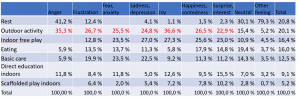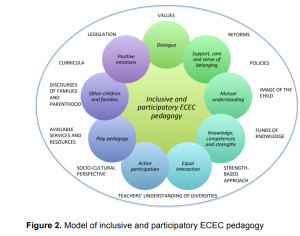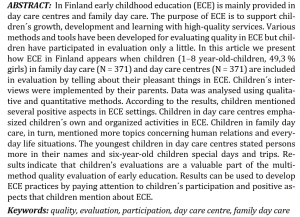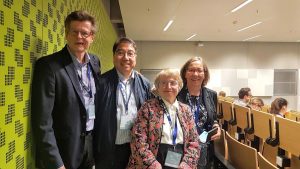Fear and anxiety are species-specific adaptation reactions. We have been observing these feelings as part of other emotions since 2015. Through random sampling, we are able to provide a reliable picture of the observed amounts of anxiety and fear and their relationship to children’s tendencies, learning environment, and leadership. Anxiety and fear occurred for an average of 43 seconds per day per child. Most fears occur in the morning. As a result, fears are over-represented in outdoor activities, the child is usually out of focus, often interrupted, and attention is concentrated on a variety of subjects. In situations of fear, the child is often withdrawn or bound to his or her own perspective. 1-3 year olds have most of fearful emotions, even though these emotions are only 0.26% of all observations. Girls have somewhat more fears than boys. However, the emotions of fear in early childhood education are not the experiences of characteristically helpless children, but those of sensitive and skillful children. Fear in early childhood education does not only appear to be negative, but it expresses the courage to experience emotions and the ability to engage with things that are important despite the fear. Only a child who feels secure enough does not prevent him from acting and facing his/her fears. (The figure shows the relationship between fear and anxiety experiences and the child’s assessed social skills in the child group. Observation and assessment are completely independent, so the connection reflects a real phenomenon.)
Below are some examples of children’s descriptions of their fears:
It’s when the adults are loud and when the adult says it
If you play ghost games – in the morning I feel anxious
if it’s dark and someone is scared
That I will be alone somewhere, and the others will leave
I’m afraid I won’t be chosen.
Loud noise. When it’s dark.
Jumping scares, climbing poles.
One boy always hits and is naughty because he hasn’t learned things yet.
If I had to do something and I don’t know if I could do it.
I’m afraid the teacher will get angry if I make an accident.
At daybreak I had dreams of wolves and they ran over me.
When the kindergarten is big.
Monsters
Well, every time someone made me stupid games and laughed. I don’t like it when I am laughed at.
All boys
If the electricity goes out






